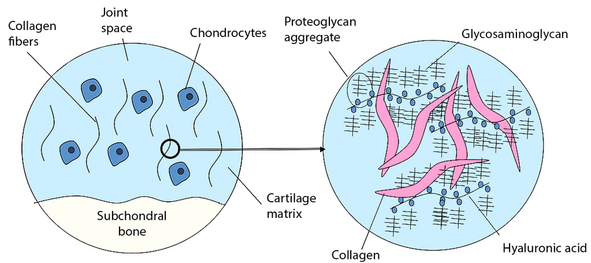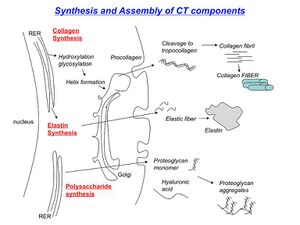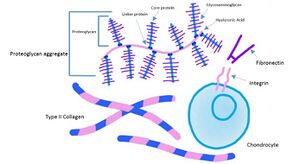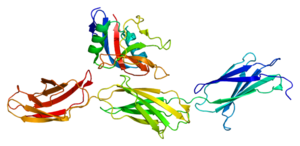Proteoglycans
Original Editor - Lucinda hampton
Top Contributors - Lucinda hampton and Tolulope Adeniji
Introduction[edit | edit source]
Proteoglycans (PGs) are composed of glycosaminoglycan (GAG) chains covalently linked to a specific protein core (with the exception of hyaluronic acid). PGs have a high molecular weight and are found especially in the extracellular matrix (ECM) of connective tissue (the fibrous tissue that gives support to the body structure). [1] PGs make up a major part of the ECM, filling the spaces that occur between cells. Interestingly the ECM is the most significant part of connective tissue.[2]
Classification[edit | edit source]
PGs may be classified according to the:
- Nature of their GAGs chains: Proteoglycans can be classified according to the glycosaminoglycans (GAGs) attached to them. The types are chondroitin sulfate, dermatan sulfate, heparin sulfate, heparan sulfate, or keratan sulfate.
- There relative size ( small or large). Large molecules eg aggrecan, important part of cartilage, versican. Small molecules eg decorin, important in angiogenesis, wound healing, bone development etc.[2].
Synthesis[edit | edit source]
Proteoglycans are synthesized in the rough endoplasmic reticulum (RER) then reshaped in the golgi body, and are ultimately transported to the extracellular matrix by vesicles.[3]
Diverse Functions[edit | edit source]
Proteoglycans are a major component of the animal extracellular matrix, being the filler between cells in an organism. Proteoglycans have an important role in the physiology and biomechanical function of tendons, ligaments and cardiovascular system via their involvement in regulation of assembly and maintenance of extracellular matrix, and as they participate in cell proliferation through their interactions with growth factors[4]. Eg
- Cartilage contains a variety of proteoglycans, being essential for its normal function. These include aggrecan, decorin, biglycan, fibromodulin and lumican. Each proteoglycan serves several functions that are determinedby both its core protein and its glycosaminoglycan chains[5]. eg Aggrecan provides cartilage with the property to bind with water to form hydrated matrices. These molecules act as fillers between the cell spaces[6].
- Proteoglycans play important roles in organizing the bone extracellular matrix, taking part in the structuring of the tissue itself as active regulators of collagen fibrillogenesis.[3]The bone matrix has a lower proteoglycan content than those in the cartilage, and hence takes up less water as is more brittle[6].
Dysfunction[edit | edit source]
An inability to break down the proteoglycans (due to absent or malfunctioning lysosomal enzymes) is characteristic of a group of genetic disorders, called mucopolysaccharidoses. Over time, these GAGs collect in the cells, blood and connective tissues. The result is permanent, progressive cellular damage which affects appearance, physical abilities, organ and system functioning.[6]
References[edit | edit source]
- ↑ Merriam Webster Proteoglcan Available:https://www.merriam-webster.com/dictionary/proteoglycan (accessed 18.6.2022)
- ↑ 2.0 2.1 All the science Proteoglycans Available: https://www.allthescience.org/what-are-proteoglycans.htm (accessed 18.6.2022)
- ↑ 3.0 3.1 Lamoureux F, Baud'huin M, Duplomb L, Heymann D, Rédini F. Proteoglycans: key partners in bone cell biology. Bioessays. 2007 Aug;29(8):758-71. Avcailable:https://pubmed.ncbi.nlm.nih.gov/17621645/ (accessed 18.6.2022)
- ↑ Halper J. Proteoglycans and diseases of soft tissues. Progress in heritable soft connective tissue diseases. 2014:49-58.Available:https://pubmed.ncbi.nlm.nih.gov/24443020/ (accessed 18.6.2022)
- ↑ Carney SL, Muir H. The structure and function of cartilage proteoglycans. Physiological reviews. 1988 Jul;68(3):858-910. Available:https://www.researchgate.net/publication/19863408_The_structure_and_function_of_cartilage_proteoglycans (accessed 18.6.2022)
- ↑ 6.0 6.1 6.2 Biology wise A Concise Overview: Structure and Functions of Proteoglycans Available:https://biologywise.com/structure-function-of-proteoglycans (accessed 18.6.2022)










